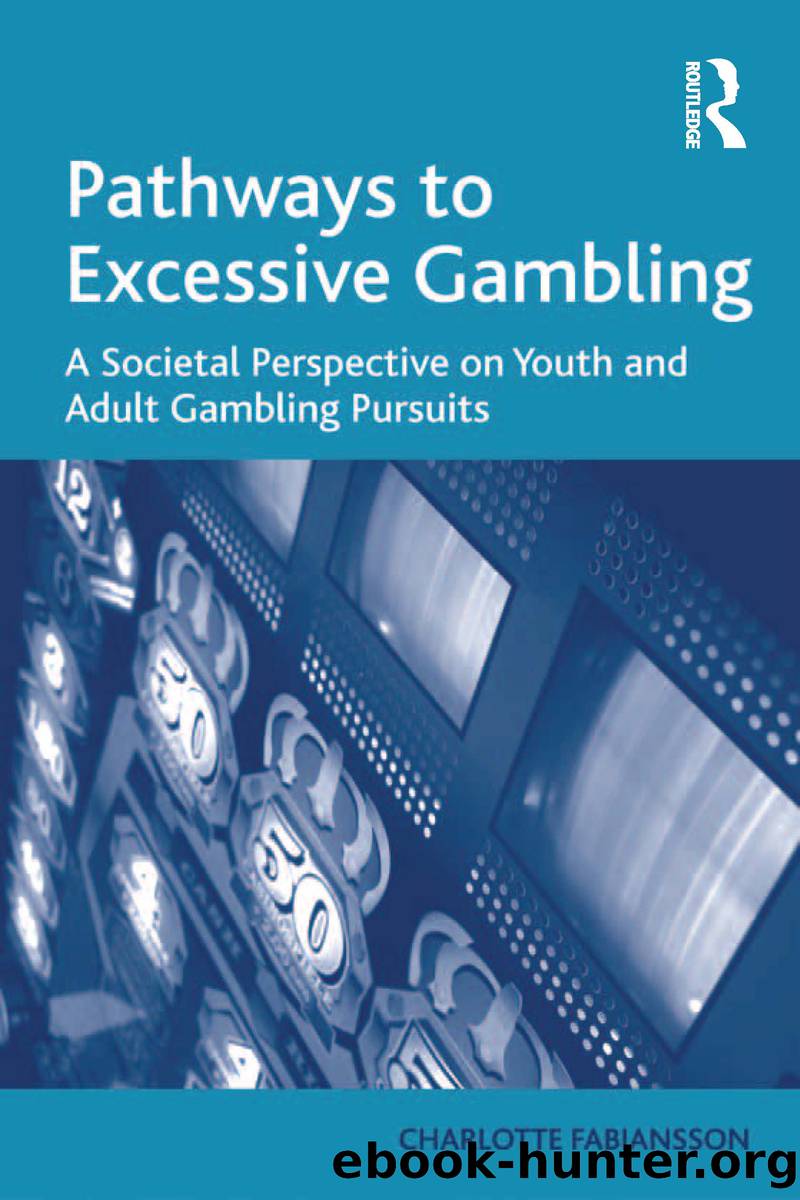Pathways to Excessive Gambling by Fabiansson Charlotte;

Author:Fabiansson, Charlotte;
Language: eng
Format: epub
Publisher: Taylor & Francis Group
Published: 2016-08-15T00:00:00+00:00
5.3 Youths' gambling experiences
5.3.1 Background
It is well documented that gambling activities are a common recreational pursuit and children are introduced to different forms of gambling within the family environment, these include board games and card games. Board and card games are played for fun as a family activity, but also as a tool to help children count and to memorise colour and the value of the card played or those still in the stack. This form of gambling is rarely an introduction to excessive gambling, but it raises the question of when the interest in gambling activities moves beyond this initial stage. Hence the purpose of the youth study was to explore young peopleâs participating in gambling activities within the family environment, with friends and by themselves. The young people were asked about their introduction to gambling, what form of gambling they participated in, with whom they gambled, how much money they spent on gambling, and how they felt about their gambling, especially how they felt about losing money.
Raffle tickets are often seen as an excellent way to raise money for the local school, local community activities and to promote good causes in the wider society. We might question whether buying a raffle ticket to support the local community, local charities and health foundations should be seen as gambling, however, raffle tickets were included in the survey as they were the only legal gambling avenue for 97.5 per cent of the respondents.
The research results are, where relevant, related to gender and four age groups. The sample includes 55.8 per cent females, thus a smaller group of males (44.2 per cent). In age groups, the 14 year olds, the 15 year olds and the 16 year olds are presented as separate age groups, while the 17 year olds are grouped together with the 18 to 25 year olds. The sample included only 19 people who were in the age bracket between 18 and 25 years, they are of the legal age to undertake gambling activities. This age group was too small to be treated as a separate age group, thus it was combined with the 17 year olds (N=132). The 17 year olds were anticipated to be more comparable to this oldest age group than with the 16 year olds age group. The 18 to 25 year olds represent 2.5 per cent of the total sample, thus will have minor influences on the total percentages.
Nearly three quarters of the youths (74 per cent) classified their living standard as good or very good (middle-class or above), and 96 per cent lived in family like situations, thus this research group can not be deemed as disadvantaged or participating in more than ânormalâ youth risk taking behaviour, the types generally related to weekend excessive drinking (cf. Goldstein et al. 2009; Modie and Finnigan 2006; Huang and Boyer 2007; Dickson, Derevensky and Gupta 2008).
The results from the youth survey show young peopleâs gambling experiences and gambling patterns, but the results also reflect their familiesâ gambling
Download
This site does not store any files on its server. We only index and link to content provided by other sites. Please contact the content providers to delete copyright contents if any and email us, we'll remove relevant links or contents immediately.
Still Foolin’ ’Em by Billy Crystal(36014)
Spell It Out by David Crystal(35825)
The Great Music City by Andrea Baker(30759)
Professional Troublemaker by Luvvie Ajayi Jones(29409)
Trainspotting by Irvine Welsh(20977)
Call Me by Your Name by André Aciman(19873)
We're Going to Need More Wine by Gabrielle Union(18608)
The Secret History by Donna Tartt(18089)
Cat's cradle by Kurt Vonnegut(14726)
Ready Player One by Cline Ernest(13938)
Molly's Game by Molly Bloom(13872)
Bombshells: Glamour Girls of a Lifetime by Sullivan Steve(13667)
The Goal (Off-Campus #4) by Elle Kennedy(13179)
Leonardo da Vinci by Walter Isaacson(12767)
The Social Justice Warrior Handbook by Lisa De Pasquale(11943)
4 3 2 1: A Novel by Paul Auster(11761)
The Break by Marian Keyes(9067)
Crazy Rich Asians by Kevin Kwan(8864)
Adultolescence by Gabbie Hanna(8575)
